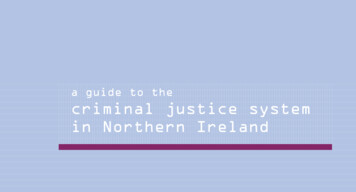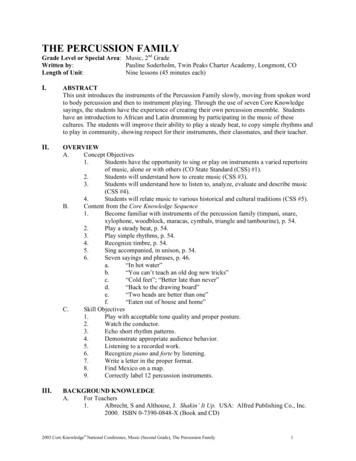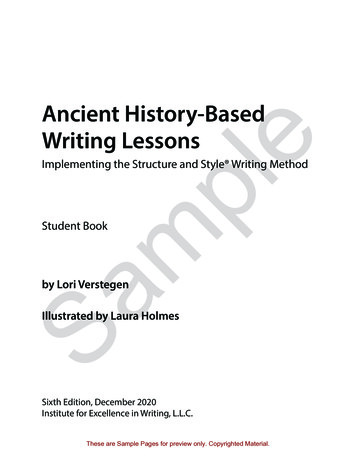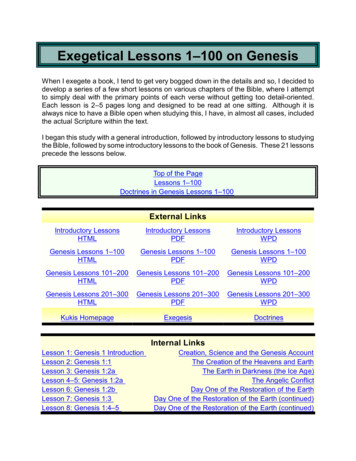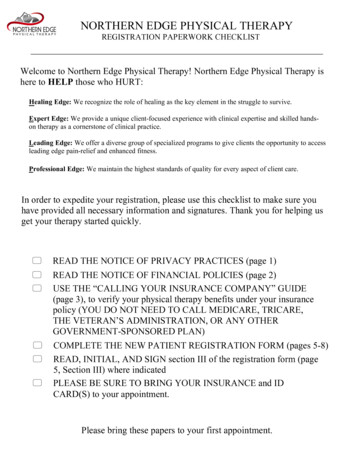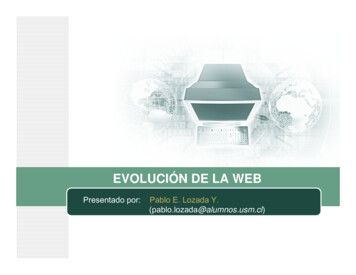
Transcription
Web LessonsLessons 1 and 2 are included in the Study Guide.Lessons 3 – 7 were put on the web in PDF format.
Table of ContentsLesson 3 – What is Distance Learning? . 1Activity 3.1 – Web Exploration . 2Activity 3.2 – Textbook, Lessons 6 & 7 . 3Activity 3.3 – Web Exploration . 4Lesson 3 Summary . 5Lesson 4 – Principles of Distance Learning Design. 6Activity 4.1 – Web Exploration . 8Activity 4.2 – Textbook . 10Activity 4.3 – Web Activity. 13Activity 4.4 – Collaborative Projects. 15Activity 4.5 – WebCT Lab. 16Lesson Summary . 20Lesson 5 – Delivering Skills Development at a Distance . 21Activity 5.1 – Textbook and PPT. 23Activity 5.2 – Videotape 2, Part A. 24Activity 5.3 – Online Reading#1 . 26Activity 5.4 – Videotape 2, Part B. 29Activity 5.5 – Textbook . 30Activity 5.6 – Online Reading #2 . 32Lesson 5 Summary . 35Lesson 6 – Facilitating Online Learning. 38Activity 6.1 – Learning Style Assessment . 39Activity 6.2 – Web Activity/Textbook. 41Activity 6.3 – Web Activity. 42Activity 6.4 – Textbook . 43Activity 6.5 – WebCT Activity. 45Activity 6.6 – WebCT Discussion . 46Activity 6.7 – Textbook . 47Lesson Summary . 48Lesson 7 – Next Steps . 49Activity 7.1 – DLTI Choices . 50Lesson Summary . 52Glossary . 53Resources . 63
Lesson 3 – What is Distance Learning?IntroductionYou may already have a good understanding of distance learning, or atleast of online learning, from your experience in this course or othercourses you have taken. However, it is important for you as a DistanceLearning and Technology Intern to have a firm foundation in distancelearning concepts including: the evolution of distance learning; howtechnology has changed over the years; the variety of technologiesavailable; and the advantages/disadvantages of each. This knowledgewill help you make informed technology choices for distance courses.Lesson Objectives and ActivitiesBy the end of this lesson you will be able to:ObjectiveActivityDescribe the advantagesand disadvantages ofdifferent technologies usedin distance learning.Activity 3.1 - Web ActivityDiscuss what it takes to bean online learner and theimplications that has forinterpreter education.Activity 3.3 - WebExplorationDatesActivity 3.2 - Textbook, YouCan Teach Online, Lessons6&7Assignment 3 - WebCTDiscussionOverall PlanYou will begin this lesson by exploring some websites about distancelearning and the technologies available for distance learning. Then,you will turn your attention to “online learning.” The textbookreadings concentrate on what online learning is and what softwaretools and delivery platforms are available for it. You will complete thelesson by discussing how all these technologies, advantages anddisadvantages, may impact interpreter education.Lesson 3 – What is Distance Learning?1
Activity 3.1 – Web ExplorationExplore these websites about distance learning:What is g/DLWhat is1.htmDL /dltech PurposeThe pre-readings provided you with basic information on distancelearning and introduced your textbooks.The purpose of this activity is to gather more information aboutdistance learning terminology and technologies.Remember, the Resource pages also contain links to many otherresources on distance learning.What to Look For:Look for the following information at the websites: Distance Education vs. Distance Learning Technologies available Mapping of technologies as to whether instructor and students areseparated by time and/or spaceWith the readings and activities so far in this class, you should be ableto answer these questions: How would you define distance learning (DL)? How long has distance learning been around? What is asynchronous communications? What is synchronous communications? What role does technology play in DL? What are the different types of interactions that can occur in DL? How has DL evolved over the years?Activity 3.1 – Web Exploration2
Activity 3.2 – Textbook, Lessons 6 & 7Textbook, You Can Teach Online, Lesson 6 “WhatAre the Tools of the Trade?”, and Lesson 7,“What Are Online Course Delivery Platforms?”PurposeIn Activity 3.1 you explored some general technologies for DistanceLearning. The purpose of this activity is to focus on the technologiesthat can be used for online learning.What to Look For:Look for the following information in the reading:Lesson 6 – “What Are the Tools of the Trade?” The differences between email, listservs, threaded discussions, chatrooms and whiteboards. What would you need to know, what software might you need, to beable to put your own course up on the Web? Do you think streaming audio and video would be useful/possiblefor your students?Lesson 7 – “What Are Online Course Delivery Platforms?” What course delivery platforms are available in addition to WebCT? How does WebCT “stack up” from a feature standpoint?Instructional InsightsThese lessons provide good background information on three keyelements for online learning: the media available (audio, video), thecommunication tools (email, discussions, chat), and the course deliveryplatforms. Some private training organizations develop their owndelivery platform, but most schools and educational institutions useone of the existing course delivery platforms to manage their onlinelearning. The course delivery platforms have the advantage ofproviding both learner tools and management or administrative toolsto make the delivery of online courses easier for both students andstaff.Activity 3.2 – Textbook, Lessons 6 & 73
Activity 3.3 – Web ExplorationWhat it takes to be an online lineLearning/StudentProfile.aspCCCOnline quiz for students, “Is Online LearningFor l?action islearnPurposeThe purpose of this activity is to start you thinking about what it takesto be a successful online student. This should be of interest to you fortwo reasons. First, as a student yourself, you should think about yourgoals and personality and consider if online learning is a good fit foryou. Second, as a potential online facilitator, you need to consider yourstudent audience and whether they are ready for distance learning andtaking courses on the Internet!What to Look ForHow do you fit the characteristics presented on the website and in thequiz? How do your potential students fit this profile? What difficultiescan you anticipate for yourself or potential students in the onlineenvironment?Notice that there is a link to the CCCOnline quiz from the first webpage. There are several other links along the right side to quizzes atother institutions and “tips for success.” Explore these to gain moreinsight into this topic.Activity 3.3 – Web Exploration4
Lesson 3 SummaryConclusionThis lesson has provided you with some background information ondistance learning and the various distance learning technologies andterminology. The goal is to provide you with a foundation for Lesson 4(Instructional Design Principles for DL) and Lesson 6 (FacilitatingOnline Learning).Key PointsKey points to remember from this lesson are: Distance learning can be described as any situation where theinstructor and students are separated by TIME and/or SPACE. The concepts of asynchronous vs. synchronous are key in definingtypes of distance learning technologies. Use of media such as audio and video needs to be considered in thecontext of the audience and their technical capabilities (computerand connection speed). Most educational institutions use a Course Delivery Platform likeWebCT or Blackboard to implement online learning. Certain types of students respond well to online learning, but itmay not be a good choice for everyone.What’s Next?The next lesson builds on your basic knowledge of distance learningand explores "Distance Learning Design." This will provide you withan overview of the process involved in designing courses to be deliveredat a distance. If you choose to complete a project for the practical partof your internship, you will explore the design of distance learning inmore detail.Activity 3.3 – Web Exploration5
Lesson 4 – Principles of Distance LearningDesignIntroductionThe purpose of this lesson is to give you a "primer" on instructionaldesign, specifically as it relates to distance learning. You may befamiliar with some of the key elements of instructional design already:adult learning theory and learning styles. Links on the Resource pagecan provide you with background information on these topics.Instructional design is a BIG topic, so the intent of this lesson is toprovide you with some basic concepts and resources related specificallyto the design of distance learning.Lesson ObjectivesBy the end of this lesson you will be able to:ObjectiveExplore instructional designmodels for Distance LearningActivityActivity 4.1 – Web ActivityDescribe how rubrics aid instudent assessmentActivity 4.3 – WebExplorationDatesActivity 4.2 – Textbook, YouCan Teach Online, Lessons8&9Discuss the criticalActivity 4.4 – PPT and Webcharacteristics of collaborative ActivityprojectsReview design strategies usedin various distance learningcoursesActivity 4.5 – WebCT LabAssignment 4 – WebCTDiscussionLesson 4 – Principles of Distance Learning Design6
Overall PlanYou will begin the lesson by looking at several instructional designmodels that can be useful for designing any type of training session.Design models provide a methodology or structure that can beextremely helpful for any project.Then, you will read two lessons in the textbook that discuss what ittakes to translate classroom content to online instruction. You will alsoexplore two essential elements of online learning design: assignmentsand collaborative projects. You'll end the lesson by exploring someonline courses and looking for different elements of course design.Lesson 4 – Principles of Distance Learning Design7
Activity 4.1 – Web ExplorationLook at these resources of differentinstructional design tmGagne’s 9 events:http://www.e-learningguru.com/articles/art3 3.htmhttp://it.coe.uga.edu/ rbranch/Design/Supplement/9Events.htmlECLASS: A design model for online courseshttp://www.westga.edu/ distance/ojdla/winter34/gerson34.htmlPowerPoint presentation on instructional designPurposeThe purpose of this activity is to introduce you to several instructionaldesign models that provide a structure or way of approaching thedesign of distance learning.What to Look ForLook for the following key points:The first website, http://fcit.coedu.usf.edu/distance/chap10.htm, is partof a course produced by the College of Education, University of SouthFlorida 1998, 1999.This site provides a good overview of distance learning, so feel free toexplore other areas. The page on Implementing Distance Learningprovides a "big picture" view of the design process starting with theNeeds Assessment and ending with Evaluation. Another model thatfollows many of these same steps is the ADDIE (Analyze, Design,Develop, Implement, Evaluate) model.These high level models provide a methodology for managing an entiredesign project. The PowerPoint show provides some background oninstructional design and the meaning of "ADDIE".Activity 4.1 – Web Exploration8
The next two sites focus on Gagne's 9 events of instruction, a modelthat works for face-to-face or distance t3 3.htmhttp://it.coe.uga.edu/ rbranch/Design/Supplement/9Events.htmlGagne’s 9 events provide a more practical approach to what needs to bedone to successfully deliver any type of training session. The secondsite provides a chart that relates each of the nine steps to someclassroom or learning technique.The last site:http://www.westga.edu/ distance/ojdla/winter34/gerson34.htmlpresents a model called ECLASS – specifically for online classes. It’san interesting, different way of looking at the process and againfocuses more on the specific lesson plan, rather than the whole courseoverview, although the author does make some comments aboutoverall course design as well.Instructional InsightsAdditional resources on instructional design models and learningtheory can be found on the Resource page for this course. All of thesetheories and models provide excellent background for the developmentof any type of training session. Please take advantage of theseresources to build a stronger foundation for yourself in instructionaldesign.If you choose to complete a project for the practical application of yourinternship, you will use an instructional design model as amethodology for your project development.Activity 4.1 – Web Exploration9
Activity 4.2 – TextbookTextbook, You Can Teach OnlineLesson 8 “Will My Teaching Style Translate ToThe Online Classroom?” and Lesson 9 “TranslatingContent to Online”PurposeThe purpose of this activity is to gain perspective on what it takes toconvert a face-to-face course to online instruction.What to Look ForLook for the following key points in the readings.Lesson 8 – Will My Teaching Style Translate To The OnlineClassroom?This lesson leads you through ways that classroom teaching techniquescan be converted to online instruction. For example, how would youaccomplish the following online? Lectures Exams Group Activities Labs Tutorials Team TeachingThe lesson also addresses the instructor’s “presence” in the course.Lesson 9 – Translating Content to OnlineThis lesson in the textbook overlaps and reinforces some of theinformation from Activity 4.1. It focuses on: How “content” is converted to online materialThe instructional design process and Gagne’s 9 eventsTips for how to design web pages for online coursesPrinciples for “best practices” in online designA “template” (Table 9.6) of the components of a course and howthese can be accomplished on the WebIntellectual and copyright issues (important!!)Activity 4.2 – Textbook10
Instructional InsightsThe Instructor/Designer/Facilitator ModelMost colleges that deliver online instruction currently use the“Instructor as Designer and Facilitator” model. An individualinstructor serves as designer and facilitator of his/her own course andhas total responsibility for converting the course content fromclassroom training to online learning. This means they need to serveas “instructional designer”, “web developer” and “facilitator.” Talkabout multiple hats!The You Can Teach Online textbook gives you an excellent perspectiveon how hard it might be to deliver online learning under this model.Look at all the areas in which you would have to become an expert inorder to succeed!Often people that are excellent classroom instructors do not have thetechnical skills required to create webpages, create audio/video andmultimedia clips, and incorporate these into a webpage for contentdelivery. In addition, many instructors do not have the instructionaldesign background that may be required for successful development ofonline learning. To counteract these problems, many institutionsmake instructional design, technical and media expertise available toinstructors who will be teaching online.However, you will still see that courses delivered from the sameinstitution may have a different “look and feel” and a different designstructure and implementation, so that students have to learn how tonavigate in the course and where to find things with each new coursethey take.DO IT Center modelThe DOIT Center has taken a different approach. Courses are designed centrally at the DO IT Center and uploadedto WebCT at the start of class.This central design ensures that all the courses have the same "lookand feel" and that students do not have to relearn navigation witheach new course. It also provides consistency in activities,assignments and materials from one course to another.In addition, as the use of media and other advanced techniquesbecome appropriate for the DO IT Center audience, they can beincorporated into the courses.Activity 4.2 – Textbook11
Individual facilitators do not create their own assignments,activities or content, but rather SUPPORT the students in theirlearning activities.Facilitators are not asked to become instructional designers orWeb experts, but rather to concentrate on what they do best asdescribed in this quote from Lesson 8:“Whether live or virtual, (good teaching) is aboutexpertise, passion, commitment, organization, andempathy for your students.”Here is an example to consider for discussion for this lesson.Suppose you are teaching a face-to-face class and realize thatthe students are just not getting it? What do you do? You can change the plan for each class and spend timereviewing the topic. You can provide additional resources for the students. You can approach the topic from a different point of view. You can give the students exercises or other practice labs todo.What problems/challenges/limitations might exist in an onlinecourse if you have this same problem?Activity 4.2 – Textbook12
Activity 4.3 – Web ActivityTypes of signments notes a.htmlAssessment techniques for online ssess6.htmlWhat is a sign a rubric sitehttp://rubistar.4teachers.org/PurposeThe purpose of this activity is to: Focus on the techniques/tools that can be used to “assess”student learning in online courses. Provide an introduction to the use of rubrics to aid in studentassessment.What to Look ForPart of designing a distance-learning course is planning for theassessment of student learning. The lessons you read in Activity 4.2introduced a few concepts in this area. Lesson 8 included a discussionof assessment techniques, concentrating mostly on midterms andexams; and, Lesson 9 included a short discussion of “assessing yourstudents” along with a section on “portfolio assessment.”This activity provides you with the opportunity to explore this topic inmore detail. Many of the assessment techniques that you are currentlyusing in face-to-face courses will also work on the Web. But, there areadditional tools/techniques you can use on the Web that may not beavailable in a classroom situation!In addition, the last two websites provide an introduction to usingrubrics for assessment.Activity 4.3 – Web Activity13
Website 1:http://pixel.fhda.edu/id/Assignments/assignments notes a.htmlThe first website provides an introduction to the types of assignmentsthat can be used including: Objective assignments like automated quizzes or tests Inquisitive assignments that require students to reflect, analyze,and extend their learningLinks to examples are also included at this site, although some of thelinks may no longer be valid.Toward the bottom of the page is a discussion of collaborativetechniques, which you will explore more in Activity 4.4.Website 2: tmlThe second website is a part of a course on designing online learningfor faculty at the University of Tennessee. It provides a niceintroduction to some of the technology-based techniques that can beused for assessment on the Web and includes both “objective tools” and“inquisitive techniques,” providing some interactive examples of thevarious tools/techniques.These two websites should provide you with some “food for thought” asyou think about how you might design a distance-learning course.What types of assignments/assessments would workbest for the type of content you would be delivering?Website 3: http://www.middleweb.com/CSLB2rubric.htmlThis site, designed for middle school teachers, provides a simplediscussion of “What is a Rubric”.Website 4: http://rubistar.4teachers.org/This site is a fun “design a rubric” site that enables you to build rubricsfor a variety of topics.Instructional InsightsShortly after the DO IT Center courses moved to the web, we beganusing rubrics to aid in student assessment. Rubrics have made itmuch easier for both the Section Facilitators and the students in theDO IT Center programs by providing concrete information on thecriteria for an A, B, C or D assignment.If you are interested in learning more about assessment and rubrics, itwill be one of the discussion group topics for Assignment 6.Activity 4.3 – Web Activity14
Activity 4.4 – Collaborative ProjectsView slide show about collaborative projectsLearn more about collaborative projects at these g/pages/cl.htmlPurposeCollaborative projects were mentioned in Lesson 8 of You Can Teach Onlineand in some of the websites you explored on various student assessmenttechniques. You have been introduced to the idea of a collaborative projectin Lesson 2, Assignment 2. Now it is time to learn more about collaborativeprojects from both a student and facilitator perspective.What to Look ForCollaboration can be a powerful activity or assignment in online courses– it helps develop a sense of community, enables students to learn fromeach other and to construct their own learning.The PowerPoint presentation and the web page for this activityprovide you with an introduction to collaborative projects. See if youcan find the following information: What are the advantages of collaborative projects? What are some of the drawbacks of collaborative projects? What are some of the ways collaborative projects might be organized?Instructional InsightsCollaborative projects can be very structured (the roles, tasks andapproach to the project are defined for the students), or they can beunstructured, forcing the students to “self-organize” to accomplish theproject. The approach used depends upon the audience (how sophisticatedand motivated are the students?) as well as the project objectives.Group work always presents challenges for both the student and theinstructor. What if a member of the group doesn’t pull his/her weight?How can grading be done equitably to recognize the contribution ofeach student? These issues need to be considered for collaborativeprojects.Activity 4.4 – Collaborative Projects15
Activity 4.5 – WebCT LabReview of courses to identify design elementsPurposeThe purpose of this activity is to enable you to see how design elementsmight be applied in different courses.What to Look ForThis lab will lead you through several courses to help you identifyvarious design elements. You will look at courses developed by the DOIT Center as well as other courses on the Web. The discussion inAssignment 4 provides you with the opportunity to discuss the courseswith your peers and to provide resources or course examples for othersto review as well.LabCourse EDI 100, developed by the DO IT CenterReturn to your “myWebCT” page and go into the EDI 100 course.Answer these questions: Who do you think the audience is? What level are they? (continuing ed, college, grad level) Why do you think this? How would you describe this course from a “structure” standpoint?(Look at the course contents)Little structure Medium structure Very structured How much support appears to be given to the students? What type of assessment is used in this course?Activity 4.5 – WebCT Lab16
Review Online CoursesThe following table contains many online courses that you can reviewfor ideas. Look for the following design elements as you review some ofthese courses. Feel free to visit as many courses as you can, but try tovisit at least three courses.Think about the following design elements as you view the courses. How easy is the course to navigate? Does the course provide all the information the student wouldneed? (Outline, assignments, discussions, etc.) How would you rate this course regarding the use of media?o Does it use media? If so, is it simple to use? Does themedia enhance the learning? What did you like about the structure and design of this course? What didn’t you like?Course URLDescriptionCourses using media:Public Health es introductory videotapeCourse on multiple intelligences –http://pdonline.ascd.org/pd demo/intro.cfm?SID 24Uses audio and interactive quizzesSample lesson from same site on Memory andUses video clip at link entitledLearning Strategies:Making Neural Connectionshttp://pdonline.ascd.org/pd demo/table c.cfm?SID 31Course from SBA on and.htmlEntire segment is a flashpresentation. Discussion boardsalso availableCourses on different learning platforms:Saint Joseph College - Sample lesson about being anonline as same course in bothBlackboard and WebCTSan Diego StateSample WebCT course withassessment link that provides ademographic survey/readinessquiz and course evaluationhttp://www.sdccdonline.net/sample course.htmActivity 4.5 – WebCT Lab17
Instructional InsightsOrganization of the CourseTable 9.6 in Lesson 9 of You Can Teach Online provides a goodoverview of what the components of a course might be. As you look atdifferent courses on the Web, you may notice similarities anddifferences in the way the courses are organized.Some courses are very structured (like the DO IT Center courses) withspecific activities and dates, while others are more self-paced. Somecourses may provide numerous optional resources and activities, whileothers provide a step-by-step plan for what the student needs to do.The organization or structure of the course depends on the audience,the content and the author or designer of the course.One area that you may see this difference is in the way assignmentsare structured. Some courses (like this DLTI and the EDI 100 course)have an assignment for every lesson. This makes it easy for studentsto understand that Assignment 3 is due in Lesson 3.However, in reality, this model doesn’t work for most courses – becausethere may not be a one-to-one relationship between the lessons and theassignments. Or, the assignments may be more complex and spanseveral lessons. For example, the course for online facilitators that youlooked at has 8 lessons, with 3 assignments.One of the reasons the DO IT Center courses have the “AssignmentOverview” page is to help students understand at a glance what theassignments are and when they are due. Based on this information,we hope that students will plan ahead to work on assignments as theycover the required course content.As you design an online course, you need to think about whatinformation will be available to the students and how you will organizethat information so that students can find and use it easily.Activity 4.5 – WebCT Lab18
Use of MediaSeveral of the courses listed above use audio and video clips to enhancethe course content. Immediately, the issue of accessibility is raised.How can you effectively make media like this available to everyone?The sample courses do it by providing a text script of the audio. This“checks the box” from the standpoint of accessibility, but does notreally provide the same experience for everyone.A better alternative, especially when the audience may contain deafindividuals, is the use of signed or captioned video in place of the videoclips.The clip you watched in Lesson 1 (Videotape 1, Part A) shows oneexample of how video can be presented for both hearing and deafstudents.The link below (also available under Activity 4.5 in the c
Describe how rubrics aid in student assessment Activity 4.3 - Web Exploration Discuss the critical characteristics of collaborative projects Activity 4.4 - PPT and Web Activity Review design strategies used in various distance learning courses Activity 4.5 - WebCT Lab Assignment 4 - WebCT Discussion


